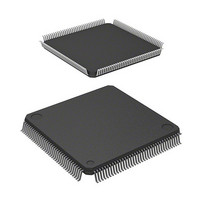R5F61665N50FPV Renesas Electronics America, R5F61665N50FPV Datasheet - Page 1093

R5F61665N50FPV
Manufacturer Part Number
R5F61665N50FPV
Description
MCU FLASH 512K ROM 144-LQFP
Manufacturer
Renesas Electronics America
Series
H8® H8SX/1600r
Datasheet
1.R5F61665N50FPV.pdf
(1492 pages)
Specifications of R5F61665N50FPV
Core Processor
H8SX
Core Size
16/32-Bit
Speed
50MHz
Connectivity
EBI/EMI, I²C, IrDA, SCI, SmartCard, USB
Peripherals
DMA, LVD, POR, PWM, WDT
Number Of I /o
92
Program Memory Size
512KB (512K x 8)
Program Memory Type
FLASH
Ram Size
40K x 8
Voltage - Supply (vcc/vdd)
3 V ~ 3.6 V
Data Converters
A/D 8x10b; D/A 2x8b
Oscillator Type
External
Operating Temperature
-20°C ~ 75°C
Package / Case
144-LQFP
Lead Free Status / RoHS Status
Lead free / RoHS Compliant
Eeprom Size
-
Available stocks
Company
Part Number
Manufacturer
Quantity
Price
Company:
Part Number:
R5F61665N50FPV
Manufacturer:
Renesas Electronics America
Quantity:
10 000
- Current page: 1093 of 1492
- Download datasheet (8Mb)
21.7
1. Confirm the ninth falling edge of the clock before issuing a stop or a repeated start condition.
2. The WAIT bit in the I
3. Restriction in transfer rate setting value in multi-master mode
4. Restriction in bit manipulation when the MST and TRS bits are set in multi-master mode
5. Notes on master receive mode
The ninth falling edge can be confirmed by monitoring the SCLO bit in the I
register B (ICCRB).
If a stop or a repeated start condition is issued at certain timing in either of the following cases,
the stop or repeated start condition may be issued incorrectly.
⎯ The rising time of the SCL signal exceeds the time given in section 21.6, Bit Synchronous
⎯ The bit synchronous circuit is activated because a slave device holds the SCL bus low
If the WAIT bit is set to 1, when a slave device holds the SCL signal low more than one
transfer clock cycle during the eighth clock, the high level period of the ninth clock may be
shorter than a given period.
When the transfer rate of I
signal the width of which is unexpected may be output. To avoid this phenomenon, set a
transfer rate of 1/1.8 or more of the fastest rate of other master to the transfer rate of I
transfer rate. For example, if the fastest rate of other masters is 400 kbps, the I
of this LSI should be 223 kbps (= 400/1.8) or more.
When the MST and TRS bits are set to master slave mode by manipulating these bits
sequentially, the conflict state occurs as follows according to the timing that arbitration is lost;
The AL bit in ICSR is set to 0, and set to master mode (MST = 1, TRS = 1). There are the
following methods to avoid this phenomenon.
•
•
In master receive mode, the RDRF bit is set to 0 at the eighth rising clock, the SCL signal is
pulled to “Low” state. When ICDRR is read near at the eighth falling clock, the SCL signal
level is released and the ninth clock is output by fixing the eighth clock of receive data to
“Low” state. Reading ICDRR is not required. As a result, the failure to receive data occurs.
There are the following methods to avoid this phenomenon.
•
Circuit, because of the load on the SCL bus (load capacitance or pull-up resistance).
during the eighth clock.
In multi-master mode, set the MST and TRS bits by MOV instruction.
When arbitration is lost, confirm that the MST and TRS bits are set to 0. If these bits are
set to other than 0, set these bits to 0.
In master receive mode, read ICDRR by the eighth rising clock.
Usage Notes
2
C bus mode register (ICMR) must be held 0.
2
C transfer of this LSI is slower than that of other master, the SCL
Rev. 2.00 Oct. 21, 2009 Page 1059 of 1454
Section 21 I
2
C Bus Interface 2 (IIC2)
2
C bus control
2
C transfer rate
REJ09B0498-0200
2
C
Related parts for R5F61665N50FPV
Image
Part Number
Description
Manufacturer
Datasheet
Request
R

Part Number:
Description:
KIT STARTER FOR M16C/29
Manufacturer:
Renesas Electronics America
Datasheet:

Part Number:
Description:
KIT STARTER FOR R8C/2D
Manufacturer:
Renesas Electronics America
Datasheet:

Part Number:
Description:
R0K33062P STARTER KIT
Manufacturer:
Renesas Electronics America
Datasheet:

Part Number:
Description:
KIT STARTER FOR R8C/23 E8A
Manufacturer:
Renesas Electronics America
Datasheet:

Part Number:
Description:
KIT STARTER FOR R8C/25
Manufacturer:
Renesas Electronics America
Datasheet:

Part Number:
Description:
KIT STARTER H8S2456 SHARPE DSPLY
Manufacturer:
Renesas Electronics America
Datasheet:

Part Number:
Description:
KIT STARTER FOR R8C38C
Manufacturer:
Renesas Electronics America
Datasheet:

Part Number:
Description:
KIT STARTER FOR R8C35C
Manufacturer:
Renesas Electronics America
Datasheet:

Part Number:
Description:
KIT STARTER FOR R8CL3AC+LCD APPS
Manufacturer:
Renesas Electronics America
Datasheet:

Part Number:
Description:
KIT STARTER FOR RX610
Manufacturer:
Renesas Electronics America
Datasheet:

Part Number:
Description:
KIT STARTER FOR R32C/118
Manufacturer:
Renesas Electronics America
Datasheet:

Part Number:
Description:
KIT DEV RSK-R8C/26-29
Manufacturer:
Renesas Electronics America
Datasheet:

Part Number:
Description:
KIT STARTER FOR SH7124
Manufacturer:
Renesas Electronics America
Datasheet:

Part Number:
Description:
KIT STARTER FOR H8SX/1622
Manufacturer:
Renesas Electronics America
Datasheet:

Part Number:
Description:
KIT DEV FOR SH7203
Manufacturer:
Renesas Electronics America
Datasheet:











